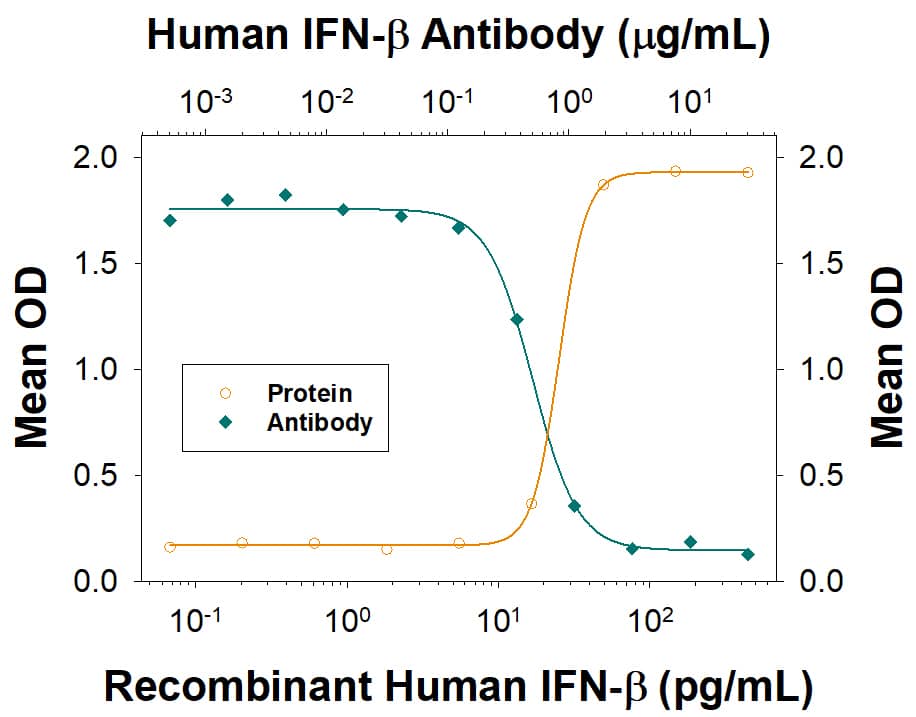Human IFN-beta Antibody
R&D Systems, part of Bio-Techne | Catalog # AF814


Key Product Details
Species Reactivity
Validated:
Cited:
Applications
Validated:
Cited:
Label
Antibody Source
Product Specifications
Immunogen
Specificity
Clonality
Host
Isotype
Endotoxin Level
Scientific Data Images for Human IFN-beta Antibody
IFN‑ beta Inhibition of EMCV-induced Cytopathy and Neutralization by Human IFN-beta Antibody.
Recombinant Human IFN-beta (8499-IF) reduces the Encephalomyocarditis Virus (EMCV)-induced cytopathy in the HeLa human cervical epithelial carcinoma cell line in a dose-dependent manner (orange line), as measured by crystal violet staining. Inhibition of EMCV activity elicited by Recombinant Human IFN-beta (50 pg/mL) is neutralized (green line) by increasing concentrations of Goat Anti-Human IFN-beta Antigen Affinity-purified Polyclonal Antibody (Catalog # AF814). The ND50 is typically 0.100 - 1.00 µg/mL.Detection of IFN-beta by Western Blot
IE1 expression leads to nuclear accumulation of STAT1.A) TetR and TetR-IE1 cells were treated with doxycycline for 72 h. Where indicated, TetR cells were incubated in the presence of IFN-gamma or IFN-alpha for 1 h before samples were fixed with paraformaldehyde and examined by indirect immunofluorescence coupled to confocal microscopy. Samples were simultaneously reacted with rabbit polyclonal antibodies against STAT1 (left) or STAT2 (right) and a mouse monoclonal antibody against IE1, followed by incubation with a rabbit-specific Alexa Fluor 546 conjugate and a mouse-specific Alexa Fluor 633 conjugate. TetRnlsEGFP (TetR) fluorescence is shown to visualize nuclei. Additionally, merge images of STAT, IE1, and TetR signals are presented. Scale bar, 10 µm. B) TetR-IE1 cells were treated with doxycycline for 0 h, 24 h, or 72 h. Cytoplasmic and nuclear extracts were prepared and subjected to immunoblotting with anti-STAT1, anti-STAT2, anti-GAPDH, anti-H2A, and anti-IE1 antibodies. For the right panel, TetR-IE1 cells were treated with IFN-alpha or IFN-gamma for 1 h before fractionation. Image collected and cropped by CiteAb from the following open publication (https://pubmed.ncbi.nlm.nih.gov/21533215), licensed under a CC-BY license. Not internally tested by R&D Systems.Applications for Human IFN-beta Antibody
Western Blot
Sample: Recombinant Human IFN-beta
Neutralization
Formulation, Preparation, and Storage
Purification
Reconstitution
Formulation
Shipping
Stability & Storage
- 12 months from date of receipt, -20 to -70 °C as supplied.
- 1 month, 2 to 8 °C under sterile conditions after reconstitution.
- 6 months, -20 to -70 °C under sterile conditions after reconstitution.
Background: IFN-beta
IFN-beta (interferon beta; also fibroblast IFN) is a secreted, monomeric 23-24 kDa member of the alpha/beta interferon family of molecules. It can be produced by almost all cell types in response to bacterial DNA or viral double-stranded RNA and is abundantly secreted by circulating plasmacytoid DCs. IFN-beta drives monocytic transformation into DCs, and it appears to stimulate a B cell switch from from IgM to IgG secretion. Mature human IFN-beta is 166 amino acids (aa) in length (aa 22-187) and contains one phosphorylation site at Ser140. There is one potential alternative start site at Met22. Full-length human IFN-beta (aa 22-187) shares 47% aa identity with mouse IFN-beta.
Long Name
Alternate Names
Gene Symbol
Additional IFN-beta Products
Product Documents for Human IFN-beta Antibody
Product Specific Notices for Human IFN-beta Antibody
Sold under license from Pestka Biomedical Laboratories, Inc. d/b/a PBL Interferon Source. For research use only. Not for resale. Not for diagnostic, therapeutic or clinical purposes.
For research use only
